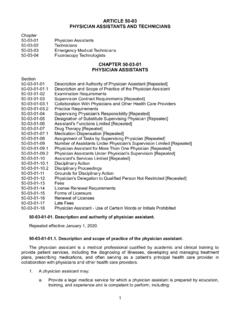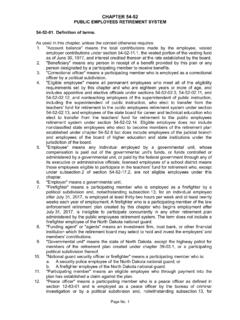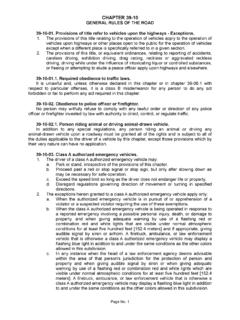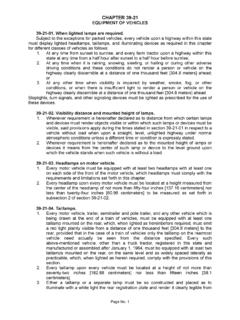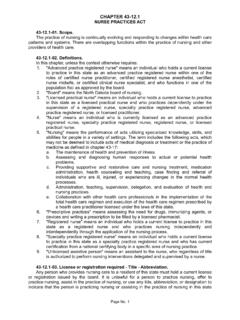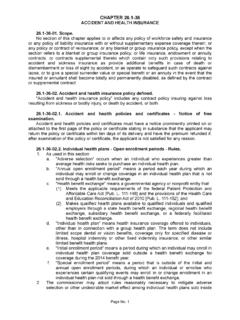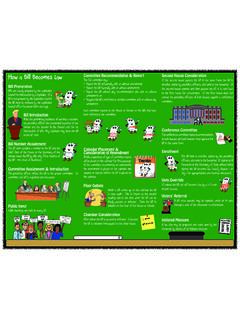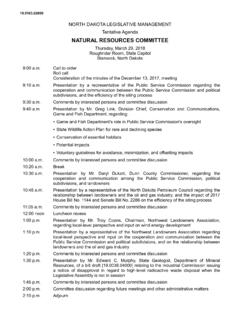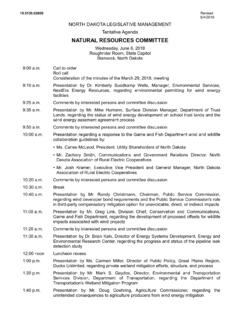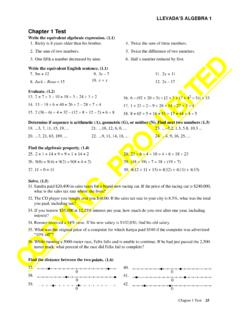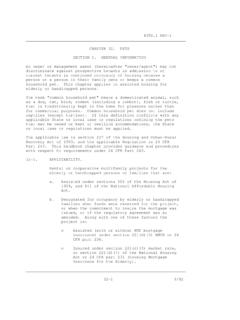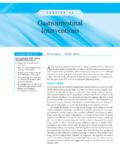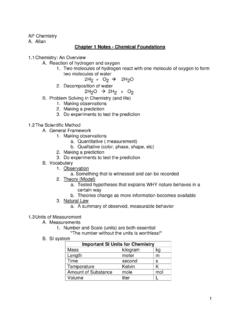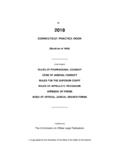Transcription of CHAPTER 12.1-32 PENALTIES AND SENTENCING …
1 CHAPTER PENALTIES AND SENTENCING . Classification of offenses - PENALTIES . Offenses are divided into seven classes, which are denominated and subject to maximum PENALTIES , as follows: 1. Class AA felony, for which a maximum penalty of life imprisonment without parole may be imposed. The court must designate whether the life imprisonment sentence imposed is with or without an opportunity for parole. Notwithstanding the provisions of section 12-59-05, a person found guilty of a class AA felony and who receives a sentence of life imprisonment with parole, shall not be eligible to have that person's sentence considered by the parole board for thirty years, less sentence reduction earned for good conduct, after that person's admission to the penitentiary.
2 2. Class A felony, for which a maximum penalty of twenty years' imprisonment, a fine of twenty thousand dollars, or both, may be imposed. 3. Class B felony, for which a maximum penalty of ten years' imprisonment, a fine of twenty thousand dollars, or both, may be imposed. 4. Class C felony, for which a maximum penalty of five years' imprisonment, a fine of ten thousand dollars, or both, may be imposed. 5. Class A misdemeanor, for which a maximum penalty of imprisonment for three hundred sixty days, a fine of three thousand dollars, or both, may be imposed. 6. Class B misdemeanor, for which a maximum penalty of thirty days' imprisonment, a fine of one thousand five hundred dollars, or both, may be imposed.
3 7. Infraction, for which a maximum fine of one thousand dollars may be imposed. Any person convicted of an infraction who has, within one year prior to commission of the infraction of which the person was convicted, been previously convicted of an offense classified as an infraction may be sentenced as though convicted of a class B. misdemeanor. If the prosecution contends that the infraction is punishable as a class B. misdemeanor, the complaint shall specify that the offense is a misdemeanor. This section shall not be construed to forbid SENTENCING under section , relating to extended sentences.
4 Organizational fines. Any organization, as defined in section , shall, upon conviction, be subject to a maximum fine in accordance with the following classification: 1. For a class A felony, a maximum fine of one hundred thousand dollars. 2. For a class B felony, a maximum fine of seventy thousand dollars. 3. For a class C felony, a maximum fine of fifty thousand dollars. 4. For a class A misdemeanor, a maximum fine of thirty thousand dollars. 5. For a class B misdemeanor, a maximum fine of twenty thousand dollars. Nothing in this section shall be construed as preventing the imposition of the sanction provided for in section , nor as preventing the prosecution of agents of the organization under section SENTENCING alternatives - Credit for time in custody - Diagnostic testing.
5 1. Every person convicted of an offense who is sentenced by the court must be sentenced to one or a combination of the following alternatives, unless the SENTENCING alternatives are otherwise specifically provided in the statute defining the offense or SENTENCING is deferred under subsection 4: a. Payment of the reasonable costs of the person's prosecution. b. Probation. c. A term of imprisonment, including intermittent imprisonment: (1) In a state correctional facility in accordance with section 29-27-07, in a regional corrections center, or in a county jail, if convicted of a felony or a class A misdemeanor.
6 Page No. 1. (2) In a county jail or in a regional corrections center, if convicted of a class B. misdemeanor. (3) In a facility or program deemed appropriate for the treatment of the individual offender, including available community-based or faith-based programs. (4) In the case of persons convicted of an offense who are under eighteen years of age at the time of SENTENCING , the court is limited to SENTENCING the minor defendant to a term of imprisonment in the custody of the department of corrections and rehabilitation. d. A fine. e. Restitution for damages resulting from the commission of the offense.
7 F. Restoration of damaged property or other appropriate work detail. g. Commitment to an appropriate licensed public or private institution for treatment of alcoholism, drug addiction, or mental disease or defect. h. Commitment to a sexual offender treatment program. Except as provided by section , sentences imposed under this subsection may not exceed in duration the maximum sentences of imprisonment provided by section , section , or as provided specifically in a statute defining an offense. This subsection does not permit the unconditional discharge of an offender following conviction.
8 A sentence under subdivision e or f must be imposed in the manner provided in section 2. Credit against any sentence to a term of imprisonment must be given by the court to a defendant for all time spent in custody as a result of the criminal charge for which the sentence was imposed or as a result of the conduct on which such charge was based. "Time spent in custody" includes time spent in custody in a jail or mental institution for the offense charged, whether that time is spent prior to trial, during trial, pending sentence, or pending appeal. The total amount of credit the defendant is entitled to for time spent in custody and any credit for sentence reduction under section or the defendant is entitled to must be stated in the criminal judgment.
9 3. A court may suspend the execution of all or a part of the sentence imposed. The court shall place the defendant on probation during the term of suspension. 4. A court, upon application or its own motion, may defer imposition of sentence. The court must place the defendant on probation during the period of deferment. An order deferring imposition of sentence is reviewable upon appeal from a verdict or judgment. In any subsequent prosecution, for any other offense, the prior conviction for which imposition of sentence is deferred may be pleaded and proved, and has the same effect as if probation had not been granted or the information or indictment dismissed under section 5.
10 A court may, prior to imposition of sentence, order the convicted offender committed to an appropriate licensed public or private institution for diagnostic testing for such period of time as may be necessary, but not to exceed thirty days. The court may, by subsequent order, extend the period of commitment for not to exceed thirty additional days. The court may also order such diagnostic testing without ordering commitment to an institution. Validity of a sentence must not be challenged on the ground that diagnostic testing was not performed pursuant to this subsection.
